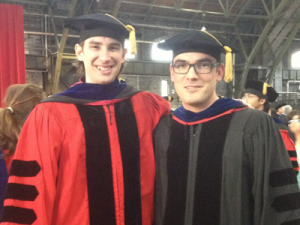Dr. Will Baumgardner defends his PhD!
Congratulations Will!

Abstract of Will’s thesis:
Quantum confined semiconductor nanocrystals, or quantum dots (QD), are a material class with tremendous technological potential. As research intensifies, there is a growing awareness that many of the fundamental assumptions of QD production are not well understood. A higher level of control over the processing methods that affect QD crystallinity, shape, and inter-QD coupling is necessary for the production of reliable, reproducible, and efficient devices. I present original research focused on the optimization of QD structures through the detailed investigation of chemical and physical processing procedures. The first synthesis of size tunable, monodisperse, quantum confined SnSe QDs is described. I discuss the implications of an unusual precursor injection sequence on the nucleation and growth process, and QD crystal structure. I continue my investigations of the synthesis method in a report describing shape control of PbSe QDs. I show that the shape of PbSe QDs can be tuned from pseudo-spherical to cubic by changing only the post-injection temperature ramp rate, a parameter not generally included in literature synthesis descriptions, exposing critical insights into the reproducibility and growth mechanisms of PbSe QDs. Device applications
often demand strict control over the inter-QD coupling while still maintaining quantum confinement. I present two studies on the fabrication of confined-but-connected (CBC) QD films. First, I introduce the pulsed laser annealing (PLA) processing strategy to the QD platform. After defining the process and its effect on QD films, I report the production of CBC structures by the PLA of amorphous silicon encapsulated PbSe QD films. The next report describes the fabrication of CBC PbSe films by facet specific displacement of surface ligands, resulting in epitaxial fusion of proximate QDs. Optical investigations demonstrate that the films retain quantum confinement while improving electrical conductivity by more than 3 orders of magnitude. Finally, the complex nanosized phase behavior of Au and Fe2O3 is investigated using in-situ temperature dependent scanning transmission electron microscopy (STEM). I demonstrate that heating the nanocrystals together results in a new bulk-forbidden composite phase. Using the STEM data, I present the first ever single-particle nanophase diagram with composition, temperature, and size dependent phase behavior.

